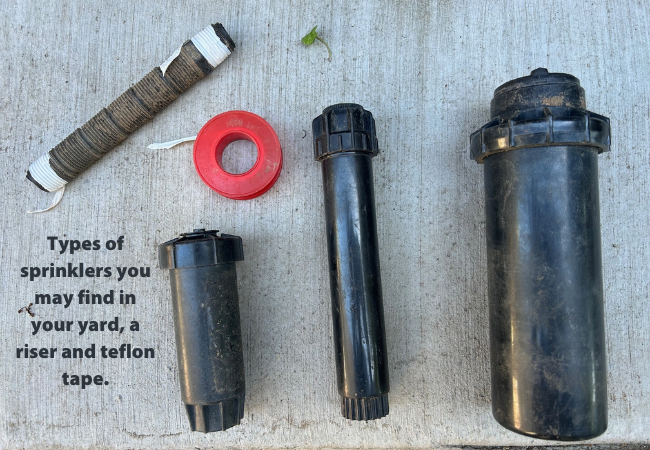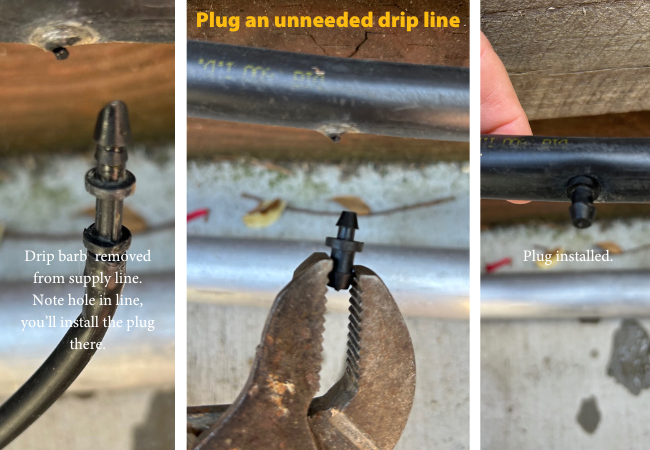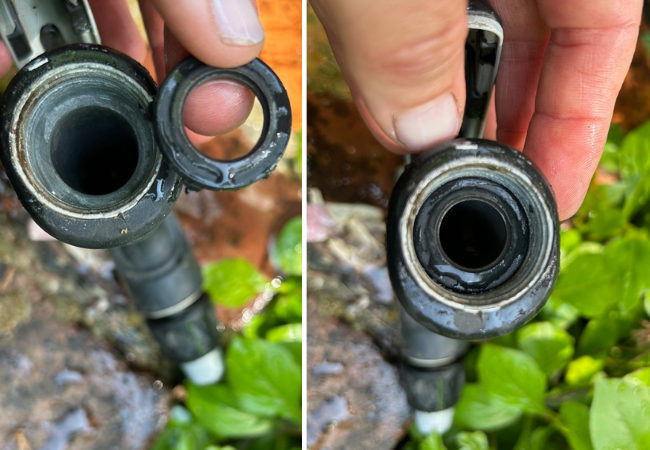No matter what you grow - trees, shrubs, flowers, veggies, turf areas - they all require some kind of irrigation in our Mediterranean climate. We had a good and late rainy season this year, so our plants were happy when the growing season kicked off and moisture ‘banks' were full. Dry and warm days are here, so now is a good time to test your sprinkler and irrigation systems to keep your garden happy and beautiful. Watering is one of the key cultural problems (culture in gardening means those activities involved in siting, selecting and caring for plants) master gardeners will ask about as they help to diagnose plant problems. Proper watering can keep some plant problems under control. Keeping ahead of irrigation problems by checking each sprinkler, drip head, or micro sprayer in your garden will ensure your plants receive the proper water to thrive and provide beauty, shade and food for your summer enjoyment.
Use this handy checklist and basic troubleshooting guide to check your watering system.
Warm Season Irrigation Checklist
Walk Your Garden
A visual inspection can help you identify problems with your irrigation system.
- Look for stunted or wilted plants that indicate a clogged or misaimed emitter or sprinkler.
- Turf areas will turn a dull gray color as they get too dry. Conduct a sprinkler/irrigation station test to reveal if there is enough water coverage for that spot. To test, turn on each irrigation station in sequence and observe the results.
- Check your plants for pests since plants suffering from under watering or over watering are more susceptible to pests and disease.
- Pay special attention to how much water is distributed during the station/zone test (see details below). Observe if all the plants are getting sufficient water, or if there is pooling under the plants or runoff onto the sidewalks
- Check any historic problem areas to ensure adequate irrigation coverage.
Irrigation Controls/Timers
If you have an automated sprinkler timer, here are the things to check as you head into the new growing season.
- If you turned off the system for the winter, turn the system back on.
- Replace the battery if your timer has one.
- Set the clock to the proper time and year.
- Check the timing for each valve and zone program
- Set time based on plant needs. You can find watering guidelines below in the Resources section.
- Set watering days and times of the week to match your water agency's watering guidelines/restrictions.
- Test each station/zone on your sprinkler timer (see below for troubleshooting repairs)
Sprinklers
Your station test from above should have helped you identify problems with your system.
- Replace broken sprinkler head “geysers” with a new sprinkler head. Most common sprinklers are easy to replace by untwisting the sprinkler from the riser (the part attached to underground piping) and replacing with the same type. Your sprinkler type may allow you to replace just the watering head. Check the manufacturer's website for full instructions.
- Use the same type of sprinkler in each zone. Not all popup sprinklers deliver the same volume.
- Use Teflon tape in the threads of the riser to ensure a leak-free seal.
- Adjust the sprinkler radius and spray pattern to get full coverage to reduce dry areas and water waste. You can find instructions for sprinkler adjustments on the sprinkler manufacturer's website as many offer instructional videos for the DIYer.
- Modern or smart sprinkler timers offer advanced settings to optimize how you water your garden. One feature, ‘cycle and soak' allows you to divide the total irrigation time into shorter intervals so the water has time to soak in. This setting is valuable for lawn areas as it promotes deep watering for root health. This also works well in sloped yards, raised beds, or heavy soils, preventing wasteful runoff. Even if your system doesn't have this feature, you can schedule several short consecutive watering times that provide the same effect.
Drip Systems
- Clean or replace clogged micro-spray heads.
- Adjust micro-spray head aim and coverage area. Squirrels, household pets and other garden visitors can knock them out of aim.
- Listen for weird squeaks, hums, whistles and gushing water noise that indicate a broken or missing drip emitter.
- Look for hard water buildup which can reduce water volume. Clean off or replace the emitter.
- Replace the broken emitter with an exact match.
- Join torn or broken drip pipes with connector pieces.
- Check that the supply tubing ends are closed to allow the system to build pressure.
- Adjust the drip system to deliver water where your plants need it now vs. when they were planted. Be sure to apply water to the entire root area. Mature plants may need another drip head or two added for adequate irrigation.
Add additional drip heads as needed for maturing landscape. Consult your irrigation design and manufacturer for the number of drip heads each zone can support. - Remove drip lines and heads in areas where they are no longer needed. It's easy to install a plug in the supply tubing.
Garden Hose and Watering Cans
If you water with a hose and watering can, don't let your trusty garden friends let you down when you most need them!
- Fully unreel your hose and inspect it for holes and cracks, smooth out hose kinks if you can and inspect bulging sides for failure. Repair or replace as needed.
- Replace hose rings at the faucet to get a tight drip-free fit.
- Replace hose rings in watering tools - wands, spray heads to keep the flow strong.
- Clean debris from watering can, inspect for holes, clogged spout and sprinkler head.
With this checklist, you have likely identified a few adjustments to your system before the temperatures soar. Continue to monitor your system for problems and make timely repairs for the best health of your garden and to avoid a surprisingly large water bill.
Resources
- Irrigating fruit and shade trees and shrubs
- Watering calculators from the Center for Landscape Urban Horticulture.
- UC Guide to Healthy Lawns
- Cultural tips for trees, shrubs and woody plants
- EBMUD Lawn and Landscape Watering Schedule (opens a pdf document)
Have a gardening question?
We'll help. You can reach us by:
- Emailing acmg@ucanr.edu. Please include a photo of the problem, if you can, plus your name, phone number, city and a description of the problem.
- Using our online form.
- By phone, during our office hours, 10 am to noon Wednesday and 11 am to 1 pm Thursday: 510-670-5645. At other times, please leave a message and we'll return your call during our office hours.
- In person at our Hayward office, during our office hours, only by appointment.


